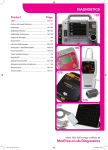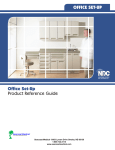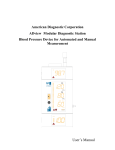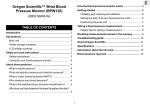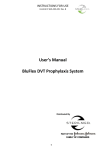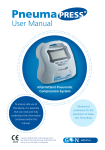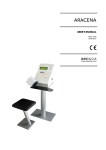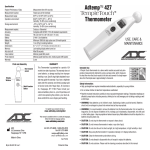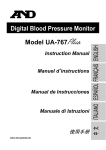Download to view the Manual Blood Pressure Kit User Manual
Transcript
6005 - IB rev 1 6/2/09 2:42 PM Page 1 MODEL 6005 Manual Home Blood Pressure Kit INSTRUCTIONS Stethoscope Bulb Cuff ADC 55 Commerce Drive Hauppauge, NY 11788 EC REP ADC (UK) Ltd. Unit 6, PO14 1TH United Kingdom IB p/n 93-6005-00 rev 1 Inspected in the U.S.A. Made in China tel: 631-273-9600, 1-800-232-2670 fax: 631-273-9659 www.adctoday.com email: info@adctoday.com Printed in China 6005 - IB rev 1 6/2/09 2:42 PM Page 3 NOTES ADC® 6005 Manual Home Blood Pressure Kit Table of Contents Introduction and Intended Use . . . . . . . . . . . . . . . . . . . . . . . . . . . . . . . . . . . . . . . . . . . . . . . . . . .4 Warnings and Precautions . . . . . . . . . . . . . . . . . . . . . . . . . . . . . . . . . . . . . . . . . . . . . . . . . . . . . .5 About Blood Pressure . . . . . . . . . . . . . . . . . . . . . . . . . . . . . . . . . . . . . . . . . . . . . . . . . . . . . . . . . .6 A. What is Blood Pressure? . . . . . . . . . . . . . . . . . . . . . . . . . . . . . . . . . . . . . . . . . . . . . . . . .6 B. What is a Normal Blood Pressure? . . . . . . . . . . . . . . . . . . . . . . . . . . . . . . . . . . . . . . . . .6 C. What influences Blood Pressure? . . . . . . . . . . . . . . . . . . . . . . . . . . . . . . . . . . . . . . . . . .6 D. Does Blood Pressure Vary? . . . . . . . . . . . . . . . . . . . . . . . . . . . . . . . . . . . . . . . . . . . . . . .7 E. What is Hypertension? . . . . . . . . . . . . . . . . . . . . . . . . . . . . . . . . . . . . . . . . . . . . . . . . .7-8 F. Can Hypertension be Controlled? . . . . . . . . . . . . . . . . . . . . . . . . . . . . . . . . . . . . . . . . . .8 G. Why Measure Blood Pressure at Home? . . . . . . . . . . . . . . . . . . . . . . . . . . . . . . . . . . .8-9 H. How is Blood Pressure Measured? . . . . . . . . . . . . . . . . . . . . . . . . . . . . . . . . . . . . . . . . .9 I. How Should I Record My Blood Pressure? . . . . . . . . . . . . . . . . . . . . . . . . . . . . . . . . . .10 Components of your Blood Pressure Kit . . . . . . . . . . . . . . . . . . . . . . . . . . . . . . . . . . . . . . . . . . .11 First Time Set-Up . . . . . . . . . . . . . . . . . . . . . . . . . . . . . . . . . . . . . . . . . . . . . . . . . . . . . . . . . . . .12 A. Assembling Your Blood Pressure Kit . . . . . . . . . . . . . . . . . . . . . . . . . . . . . . . . . . . . . . .12 How to Measure Your Blood Pressure . . . . . . . . . . . . . . . . . . . . . . . . . . . . . . . . . . . . . . . . . . . .12 A. About the Cuff . . . . . . . . . . . . . . . . . . . . . . . . . . . . . . . . . . . . . . . . . . . . . . . . . . . . . . . .12 B. To Apply the ADcuff™ Cuff to Your Arm . . . . . . . . . . . . . . . . . . . . . . . . . . . . . . . . . . . . .13 C. Correct Measuring Posture . . . . . . . . . . . . . . . . . . . . . . . . . . . . . . . . . . . . . . . . . . . . . .14 D. Operating the Instrument . . . . . . . . . . . . . . . . . . . . . . . . . . . . . . . . . . . . . . . . . . . . .15-16 Helpful Hints . . . . . . . . . . . . . . . . . . . . . . . . . . . . . . . . . . . . . . . . . . . . . . . . . . . . . . . . . . . . . . . .16 Troubleshooting . . . . . . . . . . . . . . . . . . . . . . . . . . . . . . . . . . . . . . . . . . . . . . . . . . . . . . . . . . . . .17 Care and Maintenance . . . . . . . . . . . . . . . . . . . . . . . . . . . . . . . . . . . . . . . . . . . . . . . . . . . . . .17-18 Adjusting Deflation Rate . . . . . . . . . . . . . . . . . . . . . . . . . . . . . . . . . . . . . . . . . . . . . . . . . . . . . . .18 Ordering a Different Cuff . . . . . . . . . . . . . . . . . . . . . . . . . . . . . . . . . . . . . . . . . . . . . . . . . . . . . . .19 Warranty . . . . . . . . . . . . . . . . . . . . . . . . . . . . . . . . . . . . . . . . . . . . . . . . . . . . . . . . . . . . . . . . . . .20 Quality Standards . . . . . . . . . . . . . . . . . . . . . . . . . . . . . . . . . . . . . . . . . . . . . . . . . . . . . . . . . . . .20 How to Contact ADC . . . . . . . . . . . . . . . . . . . . . . . . . . . . . . . . . . . . . . . . . . . . . . . . . . . . . . . . . .21 Techincal Specifications . . . . . . . . . . . . . . . . . . . . . . . . . . . . . . . . . . . . . . . . . . . . . . . . . . . . . . .21 22 3 6005 - IB rev 1 6/2/09 2:42 PM Page 5 General Warnings and Precautions 11. Limited Warranty American Diagnostic Corporation (ADC) warrants its products against defects in materials and workmanship under normal use and service as follows: 1. Warranty service extends to the original retail purchaser only and commences with the date of delivery. A warning statement in this manual identifies a condition or practice which, if not corrected or discontinued immediately could lead to patient injury, illness, or death. 2. The entire sphygmomanometer is warranted for one year. 3. The manometer is warranted to remain accurate to ±3mmHg over its full range when compared to a reference standard for 5 years. What is Covered: Calibration, repair, or replacement of parts and labor. What is not covered: Transportation charges. Damage caused by abuse, misuse, accident, or negligence. Incidental, special, or consequential damages. Some states do not allow the exclusion or limitation of incidental, special, or consequential damages, so this limitation may not apply to you. Implied Warranty: Any implied warranty shall be limited in duration to the terms of this warranty and in no case beyond the original selling price (except where prohibited by law. This warranty gives you specific legal rights and you may have other rights which vary from state to state. WARNING: Federal law restricts this device to sale by or on the order of a physician or licensed healthcare practitioner. WARNING: If luer lock connectors are used in the construction of tubing, there is a possibility that they might be inadvertently connected to intravascular fluid systems, allowing air to be pumped into a blood vessel. Immediately consult a physician if this occurs. WARNING: Do not allow a blood pressure cuff to remain on patient for more than 10 minutes when inflated above 10 mmHg. This may cause patient distress, disturb blood circulation, and contribute to the injury of peripheral nerves. WARNING: Safety and effectiveness with neonate cuff sizes 1 through 5 is not established. CAUTION: To Obtain Warranty Service: Send item(s) postage paid to Warranty Service Center indicated below. Please include your name and address, daytime phone no., proof of purchase, a brief note explaining the problem, and $2.00 to cover the cost of return shipping and handling. Send products in need of service to: Warranty Service Center, 55 Commerce Drive, Hauppauge, NY 11788 Unless otherwise indicated these products contain natural rubber latex, which may cause allergic reactions. WARNING: This system may fail to yield specified measurement accuracy if operated or stored in temperature or humidity conditions outside the limits stated in the specifications section of this manual. CAUTION: To avoid any possibility of accidental strangulation, keep this unit away from children and do not drape tubing around your neck. CAUTION: The standard material used for the bladder and tubing is latex-free. ATTENTION: Self-measurement means control, not diagnosis or treatment. Unusual values must always be discussed with your doctor. Under no circumstances should you alter the dosages of any drugs prescribed by your doctor. 12. Quality Standards Device standard: This device corresponds to the requirements of the European and U.S. standards for non-invasive blood pressure monitor. ANSI / AAMI SP10 ATTENTION: The pulse display is not suitable for checking the frequency of heart pacemakers! ATTENTION: In cases of irregular heartbeat, measurements made with this instrument should only be evaluated after consultation with your doctor. Note: To obtain the greatest accuracy from your blood pressure instrument, it is recommended that the instrument be used within a temperature range of 50°F (10°C) to 104°F (40°C), with a relative humidity range of 1590% (non-condensing). 20 5 6005 - IB rev 1 6/2/09 2:42 PM Page 7 • Take care when storing the cuff and tubing to avoid kinking or damage. • Do not drop the instrument or subject to strong vibration. • Do not attempt to disassemble the main unit or cuff. D. Does Blood Pressure Vary? Constantly. An individual’s blood pressure varies greatly on a daily and seasonal basis. It changes throughout one’s lifetime. It is not uncommon for systolic pressure to vary by 40mmHg or more throughout the course of a single day! While generally not as volatile, diastolic pressure can still vary significantly. In hypertensive individuals, variations are even more pronounced. Normally, blood pressure is at its lowest during sleep and rises in the morning and throughout the day. The chart below illustrates the fluctuations that could occur in a typical day. 9. Adjusting Deflation Rate Typical Fluctuation within a day Your ADC® Blood Pressure Instrument is equipped with an automatic deflation valve that releases air at the factory preset rate of approximately 2-5 mmHg per second in accordance with the recommendations of the American Heart Association. Correct deflation rate is essential to accurate readings. The deflation rate is influenced by cuff size. If using a cuff other than the one shipped with the unit, you may have to adjust the deflation rate. 1. To check the rate, begin the measurement procedure by following the instructions listed on pages 12-16. 2. Observe the positions of the indicator needle for a 10 second period during deflation. Subtract the reading at the end of the test from the reading at the beginning and divide by 10. If the rate is 2-5mmHg no further adjustment is needed. For example, if at the beginning of the test the reading was 180 and at the end the reading was 130, during a 10 second period, the rate of deflation is 5. (180-130=50, 50 /10=5). If the deflation rate is not within this range, the valve should be adjusted as follows: 1. The deflation rate adjustment screw is located on the push button of the automatic valve. With a small, flathead screwdriver, rotate adjusting screw approximately 1/8 turn clockwise to increase deflation speed, or counter clockwise to decrease speed. 2. Repeat test to determine deflation rate. 3. Continue this process until the deflation rate is between 2-5mmHg. Note: The adjustment screw is very sensitive and should be rotated gradually. E. What is Hypertension? Hypertension (high blood pressure) is elevated systolic or diastolic levels. In 90 to 95 percent of the diagnosed cases, the specific causes are unknown, although the condition is often linked with family history, and lifestyle. This is referred to as essential hypertension. In the remaining cases, high blood pressure is a symptom of an underlying, often treatable condition, which if corrected, may normalize blood pressure. This less common type is known as secondary hypertension. Hypertension, if left untreated, may contribute to kidney disease, heart attack, stroke, or other debilitating illnesses. The following standards for assessment of high blood pressure (without regard to age) have been established by the Joint National Committee on Prevention, Detection, Evaluation, and Treatment of High Blood Pressure, 2003. 18 7 6005 - IB rev 1 6/2/09 2:42 PM Page 9 9. Record Readings: If you wish to record the readings, make sure to note date and time. 10. Remove cuff, wrap it around components, and store in the carrying case provided. Note: If you wish to measure your blood pressure again, wait at least 5 to 10 minutes. 6. Helpful Hints For best results, follow the tips outlined below: Important Note: While it is important to keep an accurate record of your blood pressure measurements, don’t be overly concerned by the results of any one measurement. Individual results may be influenced by spiking of your pressure due to diet, anxiety, or mis-measurement resulting from excessive arm movement, or misapplication of the cuff. Many readings taken at the same time each day give a more comprehensive blood pressure history. Always be sure to note the date and time when recording blood pressure measurements. • Do measure your pressure the same time each day. • Do rest 5 to 10 minutes before measuring your blood pressure. • Do not eat, drink, smoke, or engage in any strenuous activity immediately before measurement. • Do allow 5 to 10 minutes rest BETWEEN subsequent measurements. • Do record the date and time measurement was made. For best results, and with time permitting, 3 successive measurements may be taken daily. Make sure to allow at least 5 to 10 minute intervals between measurements. Discard any reading that appears suspect and record the average of the remaining readings. • Do not talk, eat, drink, or move during the measurement process. • Do not allow any single measurement to concern you. Your blood pressure history is far more important. • Do not use or store the instrument in temperature extremes as it may damage the instrument and affect measurement accuracy. • Do not apply the cuff over any article of clothing. Make sure the clothing is not binding on the arm. H. How is Blood Pressure Measured? Health care professionals traditionally use a device known as a sphygmomanometer along with a stethoscope essentially a professional version of the very same instrument you have purchased. The sphygmomanometer is a system consisting of an inflatable bladder contained within a cuff, inflation bulb with air control valve, and pressure measuring manometer (gauge). The gauge may be mechanical or mercurial. The cuff is wrapped around the limb and inflated to constrict blood flow to the artery. As pressure is released from the cuff through the deflation valve, blood flow returns to the artery producing pulse beats known as Korotkoff sounds, which are detected with the stethoscope. Systolic pressure is recorded at the onset of these sounds. Diastolic pressure is generally recorded when the sounds disappear (when blood flow to the artery returns to normal). 16 9 6005 - IB rev 1 6/2/09 2:42 PM Page 11 5. Secure cuff by attaching the hook and loop adhesive. The cuff should be snug, but not tight. One finger should be able to slide easily between cuff and arm. Check to be sure the cuff is the correct size for your arm. When properly snug, the white Index line should fall between the “OK” lines printed on the cuff. If the Index line does not fall between the “OK” lines you will need to order a larger or smaller cuff. Refer to page 19 of this booklet for information on ordering other cuff sizes. 3. Components of your Blood Pressure Kit (Model #6005) 5. Manometer (gauge) 20 120 100 40 80 60 Stethoscope 300 140 160 mmHg ® 220 200 240 26 180 280 C. Correct Measuring Posture Correct measuring posture is essential to accurate measurement of your blood pressure. Inflation Bulb D-Ring ADCUFF for Home TM 1. Sit comfortably in a chair with the measurement arm resting flat on a surface so that the center of your arm is at about the same height as your heart. SELECT LARGER CUFF THIS EDGE NEARER ELBOW SELECT LARGER CUFF THIS EDGE NEARER SHOULDER INDEX Note: If the arm is above heart level you may obtain lower than ”normal“ readings. Conversely, if it is below heart level, you may obtain elevated readings. ARTERY MARK SIZE IS OK IF INDEX LINE FALLS BETWEEN OK LINES 1. OK 2. Sit upright with feet resting on the floor surface. Do not lean forward or backward during measurement. 140 160 180 120 140 160 180 ® 100 3. Relax for five to ten minutes before measurement to stabilize your pressure. 20 120 2. mmHg 280 20 300 Systolic Reading 14 240 26 40 280 20 220 60 26 40 20 80 240 60 ® 100 220 80 mmHg 300 Diastolic Reading 11






